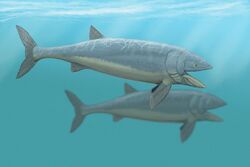| 困惑利兹鱼 化石时期:卡洛夫期至启莫里期 ~165–152 Ma | |
|---|---|

| |
| 现代人从利兹鱼化石推想出来的想像图 | |
| 生物分类法 | |
| 域: | 真核域 Eukaryota |
| 界: | 动物界 Animalia |
| 门: | 脊索动物门 Chordata |
| 亚门: | 脊椎动物亚门 Vertebrata |
| 纲: | 辐鳍鱼纲 Actinopteri |
| 目: | †厚茎鱼目 Pachycormiformes |
| 科: | †厚茎鱼科 Pachycormidae |
| 属: | †利兹鱼属 Leedsichthys |
| 种: | †困惑利兹鱼 L. problematicus |
| 学名(二名法) | |
| Leedsichthys problematicus Woodward, 1889 | |
困惑利兹鱼(学名:Leedsichthys problematicus)是利兹鱼属(学名:Leedsichthys)的唯一物种及模式种;而这个属是一种已经灭绝的巨大中生代辐鳍鱼厚茎鱼目的成员[1],生活在1亿6500万至1亿5200万年前的侏罗纪中晚期的海洋[2],直到白垩纪结束。它们代表了真骨类的一个早期分支。
本物种首个被发现的遗骸在19世纪时被认出,被认为是有史以来最巨大的硬骨鱼类。在现存鱼类中与利兹鱼最接近的是弓鳍鱼,虽然这两种鱼类之间的关系仍然距离很远。利兹鱼的名称意为“利兹的鱼”,因化石收集家Alfred Nicholson Leeds于1889年在英格兰彼得伯勒发现它的化石而得名[2]。 利兹鱼的化石可以在英格兰的卡洛夫阶、德国及法国北部、智利的牛津阶及法国的启莫里阶等地发现[3]。1999年,在智利的一次发现,学者一度以为发现了本属的第二个物种,被曾将之命名为Leedsichthys notocetes,但事后发现这个“新物种”的遗骸无法与原有的遗骸分辨,所以认为这次发现的其实亦是原来的物种。
本属物种的化石非常难以辨认及描述,因为它们的化石非常破碎:其遗骸中有不少部分由软骨组成,而这些软骨均无法成为化石;而亦有多次这些碎片被错误辨认为剑龙亚目的恐龙遗骸。因此,利兹在发现它的化石后,以problematicus作为利兹鱼的种小名[2]。
体型

虽然古生物学家已经发现几具利兹鱼的化石,但是完整的脊椎骨化石尚未发现[2],所以古生物学家很难确定它的大小,亚瑟·史密斯·伍德沃德(Arthur Smith Woodward)在1889年描述利兹鱼的标本,并拿它的尾部与另一种厚茎鱼类Hypsocormus比较后,估计它的长度大约是9米(30英尺)。古生物学家D. M. Martill在1986年拿他刚发现的利兹鱼化石[4]与其他厚茎鱼类互相比较,不过因为这具样本相当不寻常[3],所以利兹鱼推断出来的体型大小范围相当广。最近古生物学家根据历史上所发现的化石[5],及古生物学家在靠近彼得伯勒惠特西(Whittlesey)[6][7]所发现更完整的样本来估计的结果都支持亚瑟史密斯伍德沃德当时所估计的结果-9至10米(30至33英尺)。近来古生物学家使用树轮年代学来研究利兹鱼的骨骸,结果显示它们要长到这个长度需要花费21至25年[8]。而根据其他样本进行的研究显示利兹鱼最大可以长到超过16米[9](53英尺),从而推算出这种鱼比现时的鲸鲨还要重的结论[10],是不合理的推论。
与现在最大的鱼类鲸鲨及姥鲨一样,利兹鱼的食物来源是浮游动物,并且用它的嘴与鳃从水中把浮游动物给过滤出来。保存在伦敦英国自然历史博物馆的P.6924样本显示,利兹鱼遭受上龙亚目的滑齿龙攻击。这些伤口后来愈合了,这显示利兹鱼可以躲避牛津黏土组(Oxford Clay)中的侏㑩纪掠食者,很可能是因为它们具有强大的尾巴。
大众文化

利兹鱼出现于2003年英国BBC制作的《海底霸王》里,一只利兹鱼被地蜥鳄、弓鲛猎杀,最后被一只滑齿龙杀死,成了一群滑齿龙的大餐。
注释
- ↑ 体长超16米的史前巨鱼——利兹. 亚太日报. 2013-08-26 [2013-08-26].
- ↑ 2.0 2.1 2.2 2.3 Liston, 2004
- ↑ 3.0 3.1 Liston, 2008a
- ↑ Martill, 1986
- ↑ Liston & Noè, 2004
- ↑ Sloan, 2004
- ↑ Liston, 2006
- ↑ Liston, Steel & Challands, 2005
- ↑ Liston, 2005
- ↑ Barras, Colin. This ancient fish was bigger than a whale shark—and faster than scientists ever imagined. 科学 (学术期刊). 2018-05-29 [2018-06-02]. doi:10.1126/science.aau3243 (英语).
参考资料
- "Biggest Fish Ever Found" Unearthed in U.K. National Geographic News. Published October 1, 2003.
- World's Largest Fish Fossil Found in England. National Geographic News. Published October 3, 2003.
- [1]. Most comprehensive overview of Leedsichthys, see further references within for further details.
- Haines, Tim & Chambers, Paul. (2006). The Complete Guide to Prehistoric Life. Canada: Firefly Books Ltd.
- Liston, JJ (2004). An overview of the pachycormiform Leedsichthys. In: Arratia G and Tintori A (eds) Mesozoic Fishes 3 - Systematics, Paleoenvironments and Biodiversity. Verlag Dr. Friedrich Pfeil, München, pp 379–390.
- Liston, JJ (2008a). Leedsichthys des Vaches Noires au peigne fin (translation by M-C Buchy) L’Écho des Falaises (=Ech.des Fal.) No.12: 41-49, 2008 ISSN 1253-6946.
- Liston, JJ (2008b). A review of the characters of the edentulous pachycormiforms Leedsichthys, Asthenocormus and Martillichthys nov. gen. In: Mesozoic Fishes 4 Homology and Phylogeny, G. Arratia, H.-P. Schultze & M. V. H. Wilson (eds.): pp. 181–198, 10 figs., 1 tab. © 2008 by Verlag Dr. Friedrich Pfeil, München, Germany – ISBN 978-3-89937-080-5.
- Liston, JJ & Noè, LF (2004). The tail of the Jurassic fish Leedsichthys problematicus (Osteichthyes: Actinopterygii) collected by Alfred Nicholson Leeds - an example of the importance of historical records in palaeontology. Archives of Natural History 31: 236-252.
- Sloan, C (2004). Big Fish Story. National Geographic Magazine, p.42. 1/9/2004.
- Liston, JJ (2006). From Glasgow to the Star Pit and Stuttgart: A short journey around the world's longest fish. The Glasgow Naturalist 24: 59-71.
- Liston, JJ, Steel, L & Challands, TJ (2005). Lured by the Rings: Growth structures in Leedsichthys. In: Poyato-Ariza FJ (ed) Fourth International Meeting on Mesozoic Fishes - Systematics, Homology and Nomenclature, Extended Abstracts. Servicio de Publicaciones de la Universidad Autónoma de Madrid/UAM Ediciones, Madrid, pp 147–149.
- Liston, JJ (2005). Homologies amongst the fragments: searching for synapomorphies in shattered skulls. In: Poyato-Ariza FJ (ed) Fourth International Meeting on Mesozoic Fishes - Systematics, Homology and Nomenclature, Extended Abstracts. Servicio de Publicaciones de la Universidad Autónoma de Madrid/UAM Ediciones, Madrid, pp 141–145.
- Smith Woodward, A (1889). Preliminary notes on some new and little-known British Jurassic fishes. Geological Magazine Decade 3 Volume 6: 448-455.
- Smith Woodward, A (1905). A Guide to the Fossil Reptiles, Amphibians, and Fishes in the Department of Geology and Palaeontology of the British Museum (Natural History). Eighth edition. British Museum (Natural History), London. Pp xviii, 110 pages.
- Martill, DM (1986). The world's largest fish. Geology Today March-April: 61-63.
外部链接
- For more on the Star Pit dig of 2002-2003 look here
- the BBC-Open University series Fossil Detectives.
- For a more accurate reconstruction of Leedsichthys visit Paleocreations.
- The profile of Leedsichthys problematicus from the BBC series Sea Monsters
- "Biggest Fish Ever Found" Unearthed in U.K. 国家地理新闻,于2003年10月1日发布
- An article on the latest discovery of a Leedsichthys problematicus fossil估计72英尺(22米)长
- A picture of Leedsichthys problematicus
- An article on Leedsichthys from Darren Nash